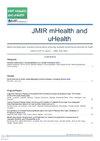通过智能 T 恤监测青少年癌症患者:前瞻性、单队列、混合方法可行性研究(OncoSmartShirt 研究)
IF 5.4
2区 医学
Q1 HEALTH CARE SCIENCES & SERVICES
引用次数: 0
摘要
背景:测量生命参数的可穿戴设备是癌症治疗期间在家监测病人的潜在工具。其中一种可穿戴设备是带有嵌入式传感器的智能 T 恤。智能 T 恤最初是为帮助运动员进行成绩分析而设计的,但其目标是成为医疗保健的辅助工具。总体而言,人们对可穿戴设备在癌症治疗期间用于症状监测的了解有限,对遵从性或依从性的共识和认识也很少。研究目的本研究旨在评估正在接受癌症治疗的青少年使用智能 T 恤进行为期两周的家庭生物测量传感器数据监测的依从性和患者体验。方法该研究是一项前瞻性、单一队列、混合方法的可行性研究。纳入标准是年龄≥18-39 岁在哥本哈根大学医院(Rigshospitalet)接受治疗的患者。智能 T 恤上有多个传感器和电极,可进行六项测量:心电图、胸部和腹部呼吸、胸部阻抗、体力活动(步数)和皮肤温度。主要终点是坚持佩戴,即佩戴时间大于 8 小时/天。通过个人半结构化电话访谈和纸质问卷调查了患者的体验。结果共纳入 10 名患者。在研究期间(14 天),佩戴时间大于 8 小时/天的患者为 0-6 天,平均为 2 天。三名患者在有数据登记的日子里,平均佩戴时间大于 8 小时/天。有数据登记的天数为 0-10 天,平均 6.4 天。对访谈进行的主题分析表明了三大主题:1)智能 T 恤很酷,但不适合癌症患者;2)技术限制了智能 T 恤的使用;3)数据监控增加了安全感。问卷调查结果显示,患者普遍对该设备有信心。结论虽然没有达到主要终点,但通过患者使用智能 T 恤的体验,我们了解到患者认识到需要新技术来改善癌症支持性护理。患者在被要求穿上智能 T 恤时表现积极。然而,由于在使用该设备时遇到了技术和实际挑战,导致患者的依从性不高。虽然可穿戴设备在家庭监测方面可能具有潜力,但目前的技术在临床应用方面还不成熟。本文章由计算机程序翻译,如有差异,请以英文原文为准。
Monitoring Adolescent and Young Adult Patients With Cancer via a Smart T-Shirt: Prospective, Single-Cohort, Mixed Methods Feasibility Study (OncoSmartShirt Study)
Background: Wearables measuring vital parameters can be potential tools for monitoring patients at home during cancer treatment. One type of wearable is a smart t-shirt with embedded sensors. Initially, the smart t-shirts were designed to aid athletes in their performance analysis but with an ambition to be a supportive tool in health care. In general, the knowledge of the use of wearables for symptom monitoring during cancer treatment is limited, and consensus and awareness about compliance or adherence are sparse. Objective: The aim of this study was to evaluate the adherence and patient experience of using a smart t-shirt for home monitoring of biometric sensor data in adolescents and young adults (AYA) undergoing cancer treatment during a two-week period. Methods Methods: The study was a prospective, single-cohort, mixed-method feasibility study. Inclusion criteria were patients ≥18-39 years receiving treatment at Copenhagen University Hospital, Rigshospitalet, D.K. Consenting patients were asked to wear the ChronolifeTM smart t-shirt for a period of two weeks. The smart t-shirt has multiple sensors and electrodes, which engender six measurements: ECG, thoracic and abdominal respiration, thoracic impedance, physical activity (steps), and skin temperature. The primary endpoint was adherence, defined as wear time > 8 hours/day. The patient experience was investigated in individual semi-structured telephone interviews and a paper questionnaire. Results: Ten patients were included. Wear time >8 h/d during the study period (14 days) varied between 0-6 days, mean 2 days. Three patients had a mean wear time >8 h/d during their days with data registration. Days with any data registration were 0-10, mean 6.4 days. The thematic analysis of interviews pointed to three main themes: 1) The smart t-shirt is cool but does not fit cancer patients; 2) The technology limits the use of the smart t-shirt; and 3) Monitoring of data increases the safety feeling. Results from the questionnaire showed that the patients generally had confidence in the device. Conclusions: Although the primary endpoint was not reached, the patients’ experience using the smart t-shirt led to the knowledge that patients acknowledged the need for new technologies for improved supportive care in cancer. The patients were positive when asked to wear the smart t-shirt. However, technical and practical challenges in using the device led to low adherence. Although wearables might have a potential for home monitoring, the present technology is immature for clinical use.
求助全文
通过发布文献求助,成功后即可免费获取论文全文。
去求助
来源期刊

JMIR mHealth and uHealth
Medicine-Health Informatics
CiteScore
12.60
自引率
4.00%
发文量
159
审稿时长
10 weeks
期刊介绍:
JMIR mHealth and uHealth (JMU, ISSN 2291-5222) is a spin-off journal of JMIR, the leading eHealth journal (Impact Factor 2016: 5.175). JMIR mHealth and uHealth is indexed in PubMed, PubMed Central, and Science Citation Index Expanded (SCIE), and in June 2017 received a stunning inaugural Impact Factor of 4.636.
The journal focusses on health and biomedical applications in mobile and tablet computing, pervasive and ubiquitous computing, wearable computing and domotics.
JMIR mHealth and uHealth publishes since 2013 and was the first mhealth journal in Pubmed. It publishes even faster and has a broader scope with including papers which are more technical or more formative/developmental than what would be published in the Journal of Medical Internet Research.
 求助内容:
求助内容: 应助结果提醒方式:
应助结果提醒方式:


